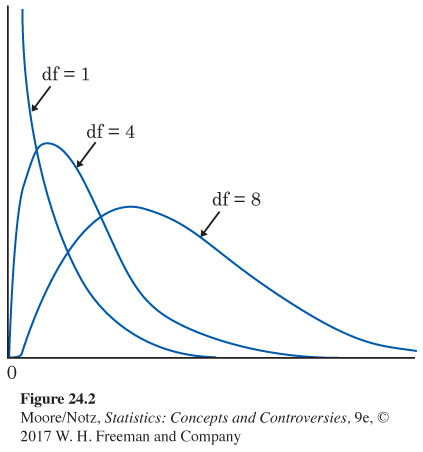EXAMPLE 5 The cocaine study, conclusion
We have seen that desipramine produced markedly more successes and fewer failures than lithium or a placebo. Comparing observed and expected counts gave the ch

| Significance Level a | |||||||
|---|---|---|---|---|---|---|---|
| df | 0.25 | 0.20 | 0.15 | 0.10 | 0.05 | 0.01 | 0.001 |
| 1 | 1.32 | 1.64 | 2.07 | 2.71 | 3.84 | 6.63 | 10.83 |
| 2 | 2.77 | 3.22 | 3.79 | 4.61 | 5.99 | 9.21 | 13.82 |
| 3 | 4.11 | 4.64 | 5.32 | 6.25 | 7.81 | 11.34 | 16.27 |
| 4 | 5.39 | 5.99 | 6.74 | 7.78 | 9.49 | 13.28 | 18.47 |
| 5 | 6.63 | 7.29 | 8.12 | 9.24 | 11.07 | 15.09 | 20.51 |
| 6 | 7.84 | 8.56 | 9.45 | 10.64 | 12.59 | 16.81 | 22.46 |
| 7 | 9.04 | 9.80 | 10.75 | 12.02 | 14.07 | 18.48 | 24.32 |
| 8 | 10.22 | 11.03 | 12.03 | 13.36 | 15.51 | 20.09 | 26.12 |
| 9 | 11.39 | 12.24 | 13.29 | 14.68 | 16.92 | 21.67 | 27.88 |
The tw
(r − 1)(c −1) = (3 − 1)(2 −1) = (2)(1) = 2
Look in the df = 2 row of Table 24.1. We see that x2 = 10.5 is larger than the
The significance test says only that we have strong evidence of some association between treatment and success. We must look at the tw